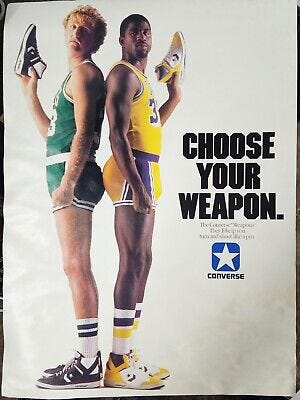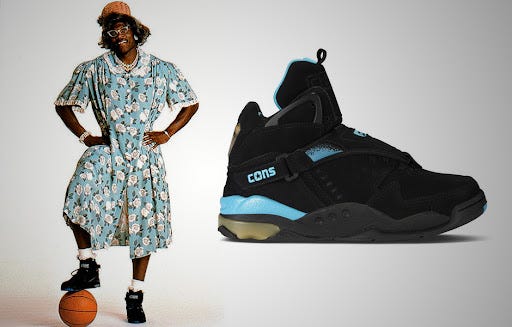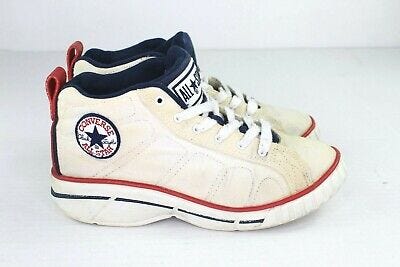Shai Gilgeous-Alexander, one of the leading contenders for the NBA’s 2024 Most Valuable Player award, is the face of an apparel line inspired by one of the original superstar basketball shoes: The Converse Weapon.
The Converse Weapon debuted in 1986, a year after Nike launched the Air Jordan1, countering the Swoosh Brand’s encroachment on the hardwood with a rare dual-endorsement — or duel, as it were.
Rivals Larry Bird and Magic Johnson appeared in promotional material for the shoe together, including an iconic poster featuring the two back-to-back, holding their respective colorways of the Converse like pistols.
SGA’s social-media spots promoting the relaunched Converse Weapon pay homage to the original, with the Oklahoma City Thunder guard shown back-to-back in images of himself wearing gear in black and white.
This isn’t the first re-release of the Weapon. Updated versions hit retailers in the early-to-mid 2000s. I was at the peak of a pop-punk phase then, and thus wore the Converse Weapon re-release for pick-up games at the University Rec Center and in intramural contests.
It was the closest thing to the Chuck Taylor — the General Issue footwork of pop-punkers nationwide — one could wear without risking a snapped ankle.
What’s more, it was an opportunity to go back to my basketball shoe roots. I’m too young for the original Converse Weapons, but the first hoops kicks I remember wearing and specifically asking my dad for as a boy were the Larry Johnson-endorsed Converse Aero Jam.
Like the original Weapon poster, the marketing campaign for LJ’s first signature was iconic and still recognizable today.
Converse managed to receive free promotion for the campaign with Johnson’s guest appearance on the sitcom Family Matters, portraying his “Grandmama” character.
The Grandmama ads were outstanding — there’s a reason ‘90s kids such as myself remember them fondly 30 years later. And Johnson’s shoes were nice!
Converse produced a few quality basketball shoes, including the Kevin Johnson signature Run-n-Slam. However,, with each new release of the Air Jordan line, Nike’s dominance of the basketball market — a space that was long the sole domain of Converse — put the One Star Brand in deeper trouble.
Nike’s growing stranglehold beyond the Air Jordan, with the popularity of Charles Barkley’s signature line and top college programs lining up to wear Swoosh-emblazoned jerseys and shoes, generated desperation within Converse.
And I’m not breaking any news when I write that desperation causes people to make poor decisions.
If you’ve read this far, you’re probably asking, What does this have to do with March Madness? This entry is labeled Madness Moments, after all.
Well, in 1996, the Kentucky Wildcats dominated on the way to the program’s first national championship since 1977. And they did so as one of the last Converse-sponsored programs in college basketball, wearing testaments to the company’s desperation.
In 1996, 10 years after the debut of the Weapon, Converse sought to counter Nike by throwing it back — but not to the Weapon. Rather, Converse debuted a modernized line of the classic Chuck Taylor.
The 1996 Chuck Taylor isn’t a bad looking shoe. A handful of teams wore them for that season’s NCAA Tournament, including a Kansas Jayhawks team featuring Jacque Vaughn, Raef LaFrentz and a freshman Paul Pierce.
But heading into the 1996 Big Dance, Kentucky was a clear overwhelming favorite to win it all. In response, Converse concocted special gear for the Wildcats.
“Special” is synonymous with “an abomination” in this instance.
Now, the ‘90s were not exactly a great decade for fashion, particularly the latter half. Some — hell, probably most — of sports’ greatest fashion disasters belong to the ‘90s, including the New York Islanders “Gordon’s Fisherman” phase and tidal waves of teal.
Kentucky basketball committed some regrettable fashion faux pas before 1996. During the 1993-94 season, the Wildcats rallied from a 31-point deficit to beat SEC rival LSU in one of the craziest games ever played.
And it’s etchedinto my childhood memory because of the hideous, tiger-stripe shorts Kentucky wore, which on TV, resembled grass Hulu skirts.
That uniform, hideous as it was, is forgivable in the context of the era. Stripes and wave patterns were en vogue, so it was an effort to match the times.
Canadian Tuxedos, however, have never been fashionable — unless you were a background character in Road House.
For the uninitiated, the Canadian Tuxedo refers to pairing blue jeans with a blue-jean shirt. Converse embraced the look for Kentucky, and took it a step further with blue-jean accented shoes.
TV spots promoting the best team in college basketball’s look proudly declared, “Denim. From head-to-toe.”
Yes, that means the shoes, too.
Denim wasn’t just a gimmicked look, either. Not initially, at least.
Wayne Turner, a reserve guard on the 1995-96 Wildcats roster, tweeted the first version of the uniforms were made of actual denim.
Perhaps the look was intended to give Kentucky a psychological edge; when I attended basketball camps growing up, a general rule of thumb dictated campers who showed up in jorts were guaranteed to be the worst players on their teams.
Maybe Kentucky was thus lulling opponents into a false sense of security, not unlike Billy Hoyle showing up on Venice Beach dressed like a goof in order to hustle locals.
Any psychological advantage gained is immediately negated by the weight and lack of sweat absorption with actual denim.
Converse adjusted course with a uniform that only looked like denim, and the next season, the Wildcats sported a more traditional look.
To be fair to Converse, Kentucky’s 1996-97 uniforms marked a vast improvement over Wildcats’ looks of years prior — including the aforementioned 1993-94 striped shorts made by Apex One2.
But by the next year, when Kentucky returned to college basketball’s mountaintop with another national championship in 1998, the Wildcats were sporting Nike.
Phil Knight’s company completed a near-monopolization of college basketball’s biggest names by the turn of the 21st Century, with a handful of exceptions, and Nike bought out Converse in 2003.
As for the basketball programs that opted for Adidas in the 21st Century, I would venture a guess a few would have welcomed a Canadian Tuxedo when the Three Stripe Brand dropped this aesthetic nightmare in 2013.
This is where I’ll note that the movie Air offers a much more realistic depiction of how the Air Jordan came to be than the idiotic and divorced from reality subplot horseshoed into an episode of the cancelled HBO vehicle Winning Time. At some point, someone needs to take a deep dive deconstructing the inaccuracies of Winning
Time, which I imagine contributed to the otherwise promising show’s cancellation after two seasons.
In the meantime, for a succinct but illuminating look at the Air Jordan, check out L. Jon Wertheim’s outstanding book Glory Days. I’ve recommended it a few times in this newsletter, but it really is one of the most fun reads I have had in the last few years.
Apex One was a short-lived ‘90s brand most notable for outfitting Kentucky and, at the peak of their dynasty, the Dallas Cowboys. In his famous, “How ‘bout them Cowboys?” locker room speech, Jimmy Johnson is wearing an Apex One puffy coat.









I'm old enough to remember when one had two choices of Converse All Stars. There was white and there was black canvas. My favorite of their leather shoes was the late 1970's model, white with one red star and blue stripes... or was it the other way around. Some of my players were in love with the "suede" blue. "Don't step on my blue suede shoes"